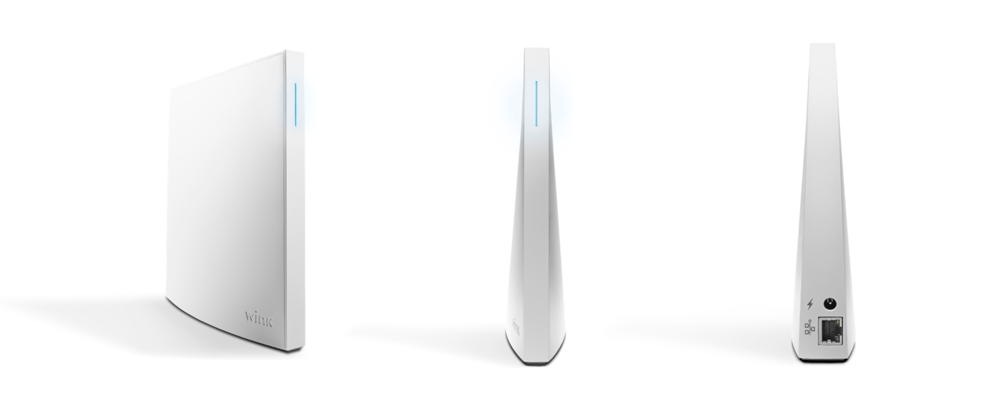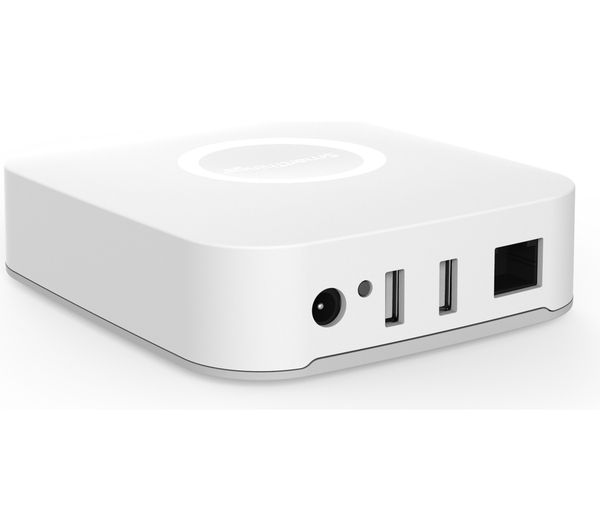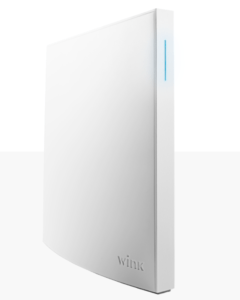With so many new devices adding smart features, it can be tough to decide which smart hub controller you should buy, spend the time to configure, and enjoy automating your home with. Do you opt for more compatibility with more devices; do you opt for the big brand name backing your smart hub; do you look for easy to use software to make programming your automation a breeze?
We took a look at two smart hubs, the Wink Hub 2 and the Samsung SmartThings Hub to compare the features of each and try to decide which hub was the better device. We’ll get this out of the way before going any further: both Wink and SmartThings ended up both being extremely capable little boxes, and for basic home users, either device will most likely get the job done.
See Wink Hub 2 user reviews or SmartThings Hub user reviews on Amazon.
Contents
A Little Background
The internet of things mainly utilizes the older 900 Mhz wireless band — like the wireless telephones you might have had, or still have, in your home. It turns out these lower band frequencies are perfect for sending basic commands to devices which do not require a ton of bandwidth. A smart hub creates a “mesh” network which can be extended through additional smart hubs or devices to provide more coverage area in your home. If you have ever seen a wifi range extender, mesh networking is based on a similar concept.
Two major standards in mesh networking have gained traction so far — Z-Wave and Zigbee — although there are some less supported standards out there. Chances are, the smart device you’ve seen at your local home improvement store run on one of these two standards. Both provide security to your data through the use of encryption, so you can feel safe in the knowledge some hacker can’t pop into your network and figure out when you’ve left the house.
Wink Hub 2

The Wink Hub 2 is a gorgeous device. It is about the size of a book, tall and narrow, and features an all white casing with a cool blue led light on the front panel letting you know the device is powered on. The hub has an Ethernet port to hardwire into your internet router, and can also be joined to your home network through your existing wireless connection. As always, the hub has a power port to keep this little guy powered up.
What We Liked
There is a lot to like about the Wink Hub 2. As mentioned, the product designers for the Wink Hub 2 deserve a raise. The hub fits most anywhere due to the extremely thin design, and the white and cool blue color scheme is very pleasing to the eye.
The Wink Hub 2 not only features both Z-Wave and Zigbee compatibility; but also includes some of the less popular mesh networking standards. Wifi devices labeled as Wink compatible work, as do some Lutron Clear Connect devices and Kidde devices. Wink also plans to enable Thread compatibility in the future. Having such a huge compatibility list is a major bonus.
The smartphone app used to control the Wink Hub 2 makes us say, “Wow!” This app is wonderfully designed, with big beautiful buttons, and an easy to use If-This-Then-That programming methodology. Additionally, Wink has added some great features which allow you to chain events together. We programmed our door lock to turn the lights on and off when we entered or exited the house. How cool is that?
Pairing devices is a breeze. After pressing the “Pair” button in the app, and selecting the device I wanted to pair, the Wink app gave me the option of watching a tutorial pairing video for that specific device. Although the pairing process is as simple as pushing the pairing button on the device after the Wink Hub 2 LED begins blinking blue, this is an amazing feature to find in a smart hub app.
Also, as with the SmartThings hub below, the Wink Hub 2 has Amazon Echo compatibility.
What We Felt Could Be Improved
Although the Wink Hub 2 has numerous mesh networking protocols for controlling smart devices, unless the device is specifically labeled as Wink-compatible, it is highly possible the smart device will not work. While our devices happen to be Wink compatible, numerous community forum users reported their smart devices as not working. While there are some workarounds for certain devices, make sure the smart device you want is labeled as Wink compatible.
The other issue we had with the Wink Hub 2 was the lack of backup battery power. This is not a huge deal breaker by any means, but you are limited to using your Wink Hub 2 to wherever you have an available power outlet. Additionally, if your area is prone to power outages, your system can go down unless you opt to plug the Wink Hub 2 into a UPS battery backup.
Final Verdict
The Wink Hub 2 is an excellent product, no question. It has a large number of compatible devices, an extremely attractive price point from various outlets, is a snap to use, and is just plain nice to look at. We feel this device is an excellent addition to any home automation system, and we have no issue recommending this smart hub to first time buyers or seasoned pros.
Samsung SmartThings Hub
[easyazon_image align=”none” height=”500″ identifier=”B010NZV0GE” locale=”US” src=”https://smartrobotichome.com/wp-content/uploads/2017/09/21HbEE3zKsL.jpg” tag=”smarthub_smartthings-winkhub-20″ width=”500″]The Samsung SmartThings Hub is another interesting entry in home automation smart hubs. A little bigger than a Roku box, this device is clad in all white, has two USB ports for powering USB devices, an Ethernet port to connect to your network, and a power port to connect to the wall. The Samsung SmartThings Hub gives you Z-Wave, Zigbee, and wifi compatibility, and is backed by one of the largest electronics manufacturers in the world.
What We Liked

The Samsung SmartThings Hub is no slouch in the product design category. While not as attractive as the Wink Hub 2, the SmartThings Hub feels very sturdy and well constructed, while giving you that same all white design. The SmartThings Hub is about a half inch taller than a standard streaming media box, and will fit just about anywhere in your home.
The SmartThings Hub is compatible with nearly Z-Wave and Zigbee product on the market, and is Amazon Echo ready. If your device doesn’t seem to work, chances are someone in the community forums has figured out a workaround and is more than willing to provide assistance if necessary. Additionally, Samsung has included a limited live chat feature in the smartphone app, to aid in any technical issues which may arise when designing and setting up your connected home.
Unlike the Wink Hub 2, the Samsung SmartThings Hub includes backup battery power, and includes 4 “AA” batteries to boot. This is a truly nice feature for those winter months when the wind or rain can knock the power out, and one we would like to see implemented in the Wink Hub 2. In the even of a power failure, the SmartThings Hub will last approximately 10 hours with 4 AA batteries installed.
The smartphone app for the Samsung SmartThings Hub is wonderfully designed, with clear labels for all the functions necessary to pair devices, create If-This-Then-That workflows, and set up notifications for multiple users when certain actions occur. Compared with the Wink app, there are no obvious occlusions, and both are dead simple to use.
What We Felt Could Be Improved
While setting up automation actions and pairing devices is extremely simple, we did find some hiccups in some of our automation processes. These are purely logic based, as the IFTTT system Samsung has implemented is fairly basic. While the process required only removing the process and starting from scratch, we feel this could be improved upon in future software iterations.
When comparing the SmartThings Hub to the Wink Hub 2, we really wish there were more mesh networking protocols available for controlling an even larger list of smart devices. While only having the basic Z-Wave and Zigbee mesh protocols available grants access to a vast array of smart devices, future products may use some of the lesser known protocols, and we would like our system to be “future-proof.”
Final Verdict
The Samsung SmartThings Hub is a great device — one we have no qualms about recommending to both new home automation buyers and seasoned vets. With a variety of devices available, a simple to use smartphone app, a large community behind the hub, and second-to-none support provided by Samsung, the SmartThings Hub can be a great centerpiece to any connected home.
Just Tell Me Which One To Get Already!
[easyazon_image align=”none” height=”333″ identifier=”B01KW8WGZQ” locale=”US” src=”https://smartrobotichome.com/wp-content/uploads/2017/09/31Pfv5BMoUL.jpg” tag=”smarthub_smartthings-winkhub-20″ width=”500″]While both the Wink Hub 2 and Samsung SmartThings Hub are great home automation controllers, we feel with a little planning, the Wink Hub 2 barely eeks out a victory here. As long as you make sure your devices are Wink compatible, the app is just a bit easier to use, includes tutorial videos, and is a little more pleasing to look at.
That is not to say the Samsung SmartThings Hub shouldn’t be strongly considered, however. If you do not think you need the additional mesh protocols the Wink provides, and live in an area prone to power outages, the SmartThings Hub might be the device for you.
Bottom Line

Get the Wink Hub 2 if you think you might purchase devices that use protocols other than ZigBee and Z-wave. See it on Amazon.
Otherwise, get the SmartThings Hub for its larger user base and support community. Check it out on Amazon.
Whichever you decide, we know you will be pleased with your decision! Welcome to the wonderful world of home automation!
Another big factor you didn’t mention is the price difference, (in my area anyway) the Wink Hub 2 is half the price of the Samsung Smartthings Hub. ($130 vs $260 Cdn)
Thank you for bringing that up! It seems that pricing for these particular smart hubs differ greatly from country to country. In the US, they are actually not too different in price.
The Specs on the Samsung Smartthings shows the battery life at 2 hours. Is that correct? If the power is out for more than the battery life, won’t it also fail?
Hi Rich,
Those specs are incorrect. With 4 AA batteries installed, the SmartThings Hub should last around 10 hours during a power outage.
Hello!
I’m interested in setting up my smart home for the very first time and I’m still on the fence about wink vs SmartThings mainly due to the fact that I am unsure if these work outside of the US.
I live in the Caribbean and can order the devices from amazon or the respective companies but I am unsure whether they will work or provde the same level of functionality as they do within the US.
Any advice or inside knowledge about non-US compatibility and functionality ?
Hi Liam,
Welcome to the smart home community! Although I don’t have any inside knowledge nor have I tested it out personally, I think that both SmartThings and Wink will work outside the US without any problems. Since these devices do not require any type of paid service plan (they just require a constant internet connection), you shouldn’t have any problems with getting them to work in the Caribbeans. Please share your experience with us if you do decide to get them for your home abroad!
Kevin
I am a long time Smartthings user, love the product on good days… Hate it on bad days, When the hub can’t talk to the cloud servers, the app doesn’t work at all. With the Smartthings version 2 hub, my remotes will work, but not the smartphone app. And unless I have a remote with a lot of buttons (can’t find one) the hub is useless if the Internet or the cloud is down. The Wink version 2 may *seem* to only “barely” seem better than smartthings… But don’t discount the value of being able to turn the lights out at night, when the ISP is doing maintenance… Wink v2 hubs work when the Internet is down, as long as your phone is on your local wifi, you still have control. I have 30 years in IoT, and the largest weakness in today’s IoT is the strong over-dependence on the cloud. Early devices were not this way, and Wink v2 rose way above Smartthings in the process. And I love Smartthings.
It seems this article missed a lot of points. I have both of these HUBs and can tell you that regardless of Wink2 supposedly having a larger compatibility it more often fails on initial setup for anything that doesn’t specifically list Wink compatibility. This is rarely the case with the SmartThings HUB. As for not being able to use the app when the ISP is down, use a USB Cellular modem, can’t do that with the WinK. I got one and pay less than $5.00 a month for the service and works wonderfully as an ISP backup. Another point, SmartThings is open source, even things that aren’t specifically listed as compatible like the Nest products, which have API information available, you can either make something yourself if you are so inclined, or there are tons of options available from others that wanted to do it. Another point is the number of devices allowed, Wink allows a maximum of 530 devices while that is virtually unlimited with SmartThings. SmartThings also is video capable Wink is not. All this is not to say that Wink is bad, but not sure I could consider it the victor. I would say the Wink app is easier to use, though not as advanced.
Thanks for the comment, your insights are much appreciated!
I’ve been reading a lot of bad reviews lately regarding wink. They seem to be halting production of their products. Not sure what this means, i would love to buy the Wink Hub 2 but can’t find it anywhere for the MSRP price. And quite frankly not sure it will be around anymore. Their website mentions nothing at all about their current situation.
You can have my Wink server. They now want $5/ month to use the thing or they will deactivate it. Thanks Wink! Mine is unplugged forever.